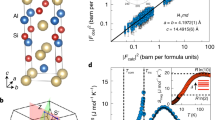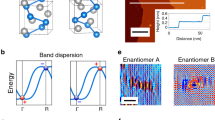Abstract
The chiral magnetic effect is the generation of an electric current induced by chirality imbalance in the presence of a magnetic field. It is a macroscopic manifestation of the quantum anomaly1,2 in relativistic field theory of chiral fermions (massless spin 1/2 particles with a definite projection of spin on momentum)—a remarkable phenomenon arising from a collective motion of particles and antiparticles in the Dirac sea. The recent discovery3,4,5,6 of Dirac semimetals with chiral quasiparticles opens a fascinating possibility to study this phenomenon in condensed matter experiments. Here we report on the measurement of magnetotransport in zirconium pentatelluride, ZrTe5, that provides strong evidence for the chiral magnetic effect. Our angle-resolved photoemission spectroscopy experiments show that this material’s electronic structure is consistent with a three-dimensional Dirac semimetal. We observe a large negative magnetoresistance when the magnetic field is parallel with the current. The measured quadratic field dependence of the magnetoconductance is a clear indication of the chiral magnetic effect. The observed phenomenon stems from the effective transmutation of a Dirac semimetal into a Weyl semimetal induced by parallel electric and magnetic fields that represent a topologically non-trivial gauge field background. We expect that the chiral magnetic effect may emerge in a wide class of materials that are near the transition between the trivial and topological insulators.
This is a preview of subscription content, access via your institution
Access options
Subscribe to this journal
Receive 12 print issues and online access
$259.00 per year
only $21.58 per issue
Buy this article
- Purchase on SpringerLink
- Instant access to full article PDF
Prices may be subject to local taxes which are calculated during checkout



Similar content being viewed by others
References
Adler, S. L. Axial-vector vertex in spinor electrodynamics. Phys. Rev. 177, 2426–2438 (1969).
Bell, J. S. & Jackiw, R. A PCAC puzzle: π0 → γγ in the σ-model. Il Nuovo Cimento A 60, 47–61 (1969).
Wang, Z. et al. Dirac semimetal and topological phase transitions in A3Bi(A = Na, K, Rb). Phys. Rev. B 85, 195320 (2012).
Wang, Z., Weng, H., Wu, Q., Dai, X. & Fang, Z. Three-dimensional Dirac semimetal and quantum transport in Cd3As2 . Phys. Rev. B 88, 125427 (2013).
Borisenko, S. et al. Experimental realization of a three-dimensional Dirac semimetal. Phys. Rev. Lett. 113, 027603 (2014).
Liu, Z. K. et al. Discovery of a three-dimensional topological Dirac semimetal, Na3Bi. Science 343, 864–867 (2014).
Nielsen, H. B. & Ninomiya, M. The Adler–Bell–Jackiw anomaly and Weyl fermions in a crystal. Phys. Lett. B 130, 389–396 (1983).
Fukushima, K., Kharzeev, D. & Warringa, H. Chiral magnetic effect. Phys. Rev. D 78, 074033 (2008).
Kharzeev, D. E. The chiral magnetic effect and anomaly-induced transport. Prog. Part. Nucl. Phys. 75, 133–151 (2014).
Kharzeev, D. Parity violation in hot QCD: Why it can happen, and how to look for it. Phys. Lett. B 633, 260–264 (2006).
Abelev, B. et al. Azimuthal charged-particle correlations and possible local strong parity violation. Phys. Rev. Lett. 103, 251601 (2009).
Abelev, B. et al. Charge separation relative to the reaction plane in Pb–Pb collisions at sNN = 2.76 TeV. Phys. Rev. Lett. 110, 012301 (2013).
Vilenkin, A. & Leahy, D. Parity nonconservation and the origin of cosmic magnetic fields. Astrophys. J. 254, 77–81 (1982).
Fröhlich, J. & Pedrini, B. New applications of the chiral anomaly. Preprint at http://arxiv.org/abs/hep-th/0002195 (2000).
Joyce, M. & Shaposhnikov, M. Primordial magnetic fields, right electrons, and the Abelian anomaly. Phys. Rev. Lett. 79, 1193–1196 (1997).
Giovannini, M. & Shaposhnikov, M. E. Primordial hypermagnetic fields and the triangle anomaly. Phys. Rev. D 57, 2186–2206 (1998).
Vachaspati, T. Estimate of the primordial magnetic field helicity. Phys. Rev. Lett. 87, 251302 (2001).
Son, D. T. & Spivak, B. Z. Chiral anomaly and classical negative magnetoresistance of Weyl metals. Phys. Rev. B 88, 104412 (2013).
Burkov, A. A. Chiral anomaly and diffusive magnetotransport in Weyl metals. Phys. Rev. Lett. 113, 247203 (2014).
Okada, S., Sambongi, T. & Ido, M. Giant resistivity anomaly in ZrTe5 . J. Phys. Soc. Jpn 49, 839–840 (1980).
Tritt, T. et al. Large enhancement of the resistive anomaly in the pentatelluride materials HfTe5 and ZrTe5 with applied magnetic field. Phys. Rev. B 60, 7816–7819 (1999).
Whangbo, M., DiSalvo, F. & Fleming, R. Electronic structure of ZrTe5 . Phys. Rev. B 26, 687–689 (1982).
McIlroy, D. N. et al. Observation of a semimetal-semiconductor phase transition in the intermetallic ZrTe5 . J. Phys. Condens. Matter 16, L359–L365 (2004).
Kamm, G., Gillespie, D., Ehrlich, A., Wieting, T. & Levy, F. Fermi surface, effective masses, and Dingle temperatures of ZrTe5 as derived from the Shubnikov-de Haas effect. Phys. Rev. B 31, 7617–7623 (1985).
Weng, H., Dai, X. & Fang, Z. Transition-metal pentatelluride ZrTe5 and HfTe5 . Phys. Rev. X 4, 011002 (2014).
He, L. P. et al. Quantum transport evidence for the three-dimensional Dirac semimetal phase in Cd3As2 . Phys. Rev. Lett. 113, 246402 (2014).
Xiong, J. et al. Evidence for the chiral anomaly in the Dirac semimetal Na3Bi. Science 350, 413–416 (2015).
Huang, X. et al. Observation of the chiral-anomaly-induced negative magnetoresistance in 3d Weyl semimetal TaAs. Phys. Rev. X 5, 031023 (2015).
Yang, X., Li, Y., Wang, Z., Zhen, Y. & Xu, Z.-A. Observation of negative magnetoresistance and nontrivial π Berrys phase in 3D Weyl semi-metal NbAs. Preprint at http://arxiv.org/abs/1506.02283 (2015).
Wang, Z. et al. Helicity protected ultrahigh mobility Weyl fermions in NbP. Preprint at http://arxiv.org/abs/1506.00924 (2015).
Shekhar, C. et al. Large and unsaturated negative magnetoresistance induced by the chiral anomaly in the Weyl semimetal TaP. Preprint at http://arxiv.org/abs/1506.06577 (2015).
Li, C.-Z. et al. Giant negative magnetoresistance induced by the chiral anomaly in individual Cd3As2 nanowires. Nature Commun. 6, 10137 (2015).
Kim, H.-J. et al. Dirac versus Weyl fermions in topological insulators: Adler–Bell–Jackiw anomaly in transport phenomena. Phys. Rev. Lett. 111, 246603 (2013).
Pippard, A. Magnetoresistance in Metals. Cambridge Studies in Low Temperature Physics (Cambridge Univ. Press, 1989).
Ali, M. N. et al. Large, non-saturating magnetoresistance in WTe2 . Nature 514, 205–208 (2014).
Pletikosić, I., Ali, M. N., Fedorov, A. V., Cava, R. J. & Valla, T. Electronic structure basis for the extraordinary magnetoresistance in WTe2 . Phys. Rev. Lett. 113, 216601 (2014).
Chen, R. Y. et al. Magnetoinfrared spectroscopy of Landau levels and Zeeman splitting of three-dimensional massless Dirac fermions in ZrTe5 . Phys. Rev. Lett. 115, 176404 (2015).
Acknowledgements
We thank J. Misewich, P. Johnson, A. Abanov and G. Monteiro for discussions. This work was supported by the US Department of Energy, Office of Basic Energy Sciences, contracts No. DE-AC02-98CH10886, No. DE-FG-88ER40388, Office of Nuclear Physics, contract No. DE-FG-88ER41723 and ARO MURI Program, grant W911NF-12-1-0461. ALS is operated by the US DOE under Contract No. DE-AC02-05CH11231.
Author information
Authors and Affiliations
Contributions
D.E.K. designed and, with Q.L. and T.V., directed the study, analysed results, and wrote the manuscript. Q.L. and C.Z. performed the transport measurements and analysed results. R.D.Z., J.A.S. and G.D.G. grew the crystals and performed X-ray diffraction experiments, Y.H. performed the SEM/TEM measurements and provided analysis. I.P., A.V.F. and T.V. performed the ARPES measurements and analysed results. All authors made contributions to writing the manuscript.
Corresponding authors
Ethics declarations
Competing interests
The authors declare no competing financial interests.
Supplementary information
Supplementary information
Supplementary information (PDF 396 kb)
Rights and permissions
About this article
Cite this article
Li, Q., Kharzeev, D., Zhang, C. et al. Chiral magnetic effect in ZrTe5. Nature Phys 12, 550–554 (2016). https://doi.org/10.1038/nphys3648
Received:
Accepted:
Published:
Issue Date:
DOI: https://doi.org/10.1038/nphys3648



